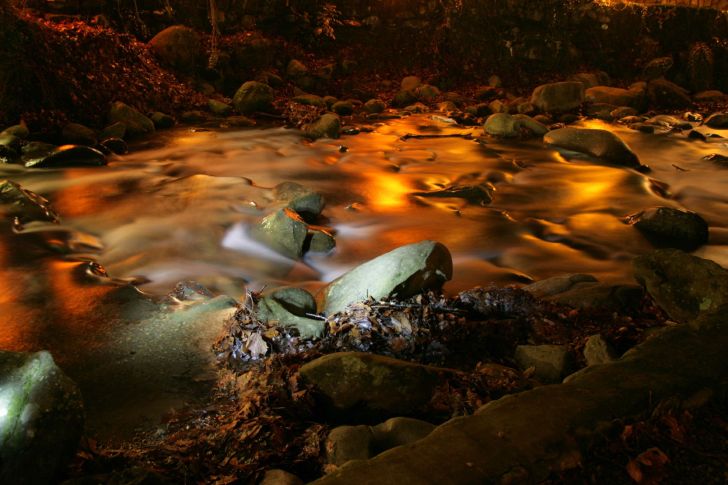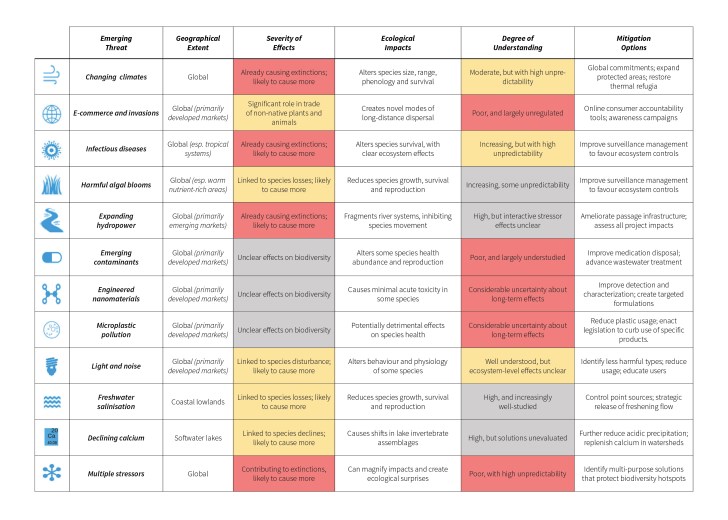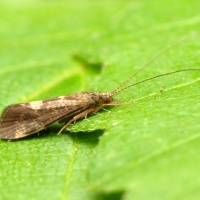Emerging threats and persistent conservation challenges for freshwater biodiversity

Numerous new threats to freshwater ecosystems have emerged in the last decade – many of which are poorly understood and difficult to manage. Image: Mark Strozier | Flickr Creative Commons
In 2006, freshwater scientist David Dudgeon and colleagues published a comprehensive review of the threats facing freshwater ecosystems and the urgent conservation actions required to tackle them. In the twelve years since their widely-cited review, the outlook for freshwater biodiversity has worsened, with freshwater species exhibiting steeper population declines (see our blog here) than marine and terrestrial species.
Dudgeon and colleagues identified five key threats to freshwater ecosystems: overexploitation; water pollution; flow modification; destruction and degradation of habitat; and invasion by exotic species. In the years since their paper, many of these threats have become more widespread and complex, whilst new and emerging threats have been identified, and the harmful effects of multiple stressors have been increasingly documented.
In other words, freshwater conservation now takes place in what is increasingly called the Anthropocene – a geological epoch characterised by human activity affecting environments and ecosystems at all scales.

A stream illuminated by street lights. Light pollution is one of the emerging threats to freshwater ecosystems identified by the review. Image: Eric Flemin
In this context, a new review of emerging threats to freshwater biodiversity, and the conservation challenges they pose, has been published. The review, led by Andrea Reid from the Fish Ecology and Conservation Physiology Laboratory at Carleton University, Canada, argues that the Anthropocene has brought numerous new and varied threats that disproportionately impact freshwater systems. Writing in Biological Reviews, the authors state that new and effective conservation strategies are needed to address emerging threats, particularly because whilst freshwaters cover only 2.3% of the Earth’s surface, they support at least 9.5% of the Earth’s described animal species.
Reid says, “Since 1970, freshwater species have declined by a staggering 81% compared with <40% species declines both on land and in our oceans – why is freshwater biodiversity declining so severely and what are the biggest threats putting freshwater species in jeopardy? Freshwater ecosystems, like our lakes, rivers and wetlands, surround us and we rely on them for clean drinking water, hydropower, nutrition, recreation, navigation, scenic values, and much more. As these ecosystems become increasingly endangered, their ability to provide these services that underpin human wellbeing gets diminished.
Sadly, the current scale of freshwater declines is now so grave that we consider it an invisible tragedy – hidden beneath the water surface – that attracts far too little public, political, and even scientific interest. We are hoping to change this narrative through the publication of our article.”

The twelve key emerging threats to freshwater ecosystems and their characteristics. Adapted from Reid et al 2018.
The authors identify twelve threats to global freshwater biodiversity which have either emerged or intensified since Dudgeon and colleagues’ 2006 review. Summarised in the graphic above, the paper shows the startling range of pressures on global freshwater ecosystems, which can potentially act in tandem in unpredictable ways as multiple stressor ‘cocktails’.
Co-author Prof Steve Ormerod, from Cardiff University School of Biosciences explains, “In this new review we wanted to update the story told by Dudgeon and colleagues – particularly with respect to problems affecting freshwater ecosystems that have emerged more prominently: climate change, invasions, diseases, harmful algal blooms, expanding hydropower, emerging contaminants, engineered nanomaterials, microplastics, light and noise, salinisation, declining calcium concentrations and cumulative stressors.
For each, we offer a specific overview, but come to the general view that an already dire prognosis for freshwater biodiversity is worsening while still being overlooked by many – perhaps even most – conservation biologists and ecologists. Mindful of the need to inspire action, however, we offer evidence where restorative and protective actions have benefited freshwater ecosystems: without hope, we cannot bring about the global efforts required to protect fresh waters as ecosystems that are fundamental our own ability to survive.”

Microplastic pollution is one of the twelve emerging threats identified in the study. Image: Florida Sea Grant | Flickr Creative Commons
The authors highlight five approaches to freshwater management and conservation which have the potential to address some of the emerging threats. First, environmental DNA (or eDNA) can be detected in water samples to detect the presence of rare and endangered species, or to track the spread of invasive species. Second, maintaining natural water allocations and variability (or environmental flows) in rivers and streams threatened by abstraction or flow alterations is an increasingly popular management approach to support resilient freshwater ecosystems.
Third, the negative impacts of aquaculture – parasites and invasive species, for example – can be minimised by supporting healthy freshwater ecosystems with fish stocks which can be sustainably harvested, the authors argue. Fourth, removing river obstacles such as dams and fishways can have significant ecological benefits to migratory species, although dam construction rates remain high in many areas. Fifth, the authors highlight the potential of managed relocation of species which will lose their climatic niche under future climate change; however, they note that this is a strategy with high levels of uncertainty over both appropriateness and effectiveness.
The authors highlight a number of freshwater conservation policy mechanisms and societal groups which might help mitigate emerging threats. These include regulatory instruments (e.g. The Water Framework Directive); fiscal incentives (e.g. agri-environment schemes); market opportunities (e.g. investments in ecosystem services with financial returns); and societal actions (e.g. campaigning for dam removal, participation in conservation activities, framing freshwaters as a political voting issue). Accordingly, the authors advocate for an increased global focus on freshwater threats and conservation, citing the recently formed Alliance for Freshwater Life, the 10 steps for responsible inland fisheries in the Rome Declaration and the post-2020 planning beyond the Aichi Biodiversity Targets as important steps in this direction.
However, the new review clearly highlights the significant multiple pressures – some known, some emerging – that are causing ongoing biodiversity losses in freshwater ecosystems across the world. Awareness of these threats and trends must spark positive conservation action. As the authors conclude, “We are merely at the beginning of the ‘great acceleration’ of the Anthropocene. Indeed, we may not even be able to imagine which environmental challenges we will face in the coming decades. In order to protect biodiversity and to support human well-being, we need to manage fresh waters collectively across sectors and as hybrid systems – managing freshwater ecosystems as both a pivotal resource for humans as well as highly valuable ecosystems.”















Comments are closed.